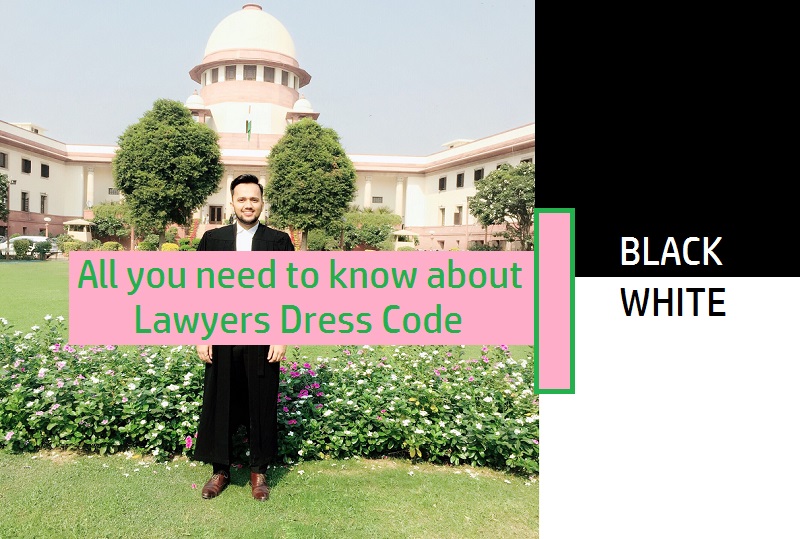The Black and White: All you need to know about Lawyers Dress Code
In this article i.e. “The Black and White” we will be discussing the origin, significance and myths with respect to the dress code of lawyers and judges. Introduction – The Black and White Lawyers and judges are the professionals serving in the judiciary of our country. They are the one who is contributing to maintaining the lawful system… Read More »

In this article i.e. “The Black and White” we will be discussing the origin, significance and myths with respect to the dress code of lawyers and judges.
Introduction – The Black and White
Lawyers and judges are the professionals serving in the judiciary of our country. They are the one who is contributing to maintaining the lawful system in the country. They are the warriors of the battle of justice. This battle of justice is fought in the courtroom. And one thing that always attracted my attention is the dress code of the judgès and the lawyers. There is always a standard and very decent dress code always maintained in court by all the judges and courtroom.
In countries like Canada, lawyers wear a red and white uniform, while in some other European countries there is a wig attached to the traditional black and white dress. However, the majority of the lawyers across the whole world wear a black and white uniform. In our country too, both male and female lawyers are ultimately needed to wear a black dress. A white shirt with a black trouser and gown and a white neck-band on top of it is common.
In India, Advocates Act 1961 has provisions related to the mind-sets behind such a dress code and the idea of the colour revolves around the whole universe. Dress code is the symbol of confidence and symbol of profession.
If we talk about black colour it stands for power and aggression as I mentioned earlier it has relevance with the universe let’s link it to astrology here we can connect while saying that the god of justice Shani is also black it’s a mythological approach.
Basically, Advocates Act 1961 took many approaches and then they came to the final conclusion on the basis of study and observance. We’ll be discussing it quickly from the beginning.
I. The Gown and the Wig
In 1685, when King Charles II died, the people started wearing a gown as tribute to there king in his condolence. The King was very powerful and strong-headed. It was then that the uniform for lawyers was designated. It was believed that wearing a wig and a gown awarded a degree of anonymity to the lawyer and judges. Wigs first appeared in the 17th century in the legal profession during the reign of restoration of the monarchy.
Lawyers and judges started wearing wigs around 1680 for 150 years the wig was usually powered with white and grey hair. The black colour is filled with many overtones like every colour it is filled with both positive and negative connections.
On one hand it signifies death, evil and mystery and on the other hand it signifies STRENGTH AND AUTHORITY. The word strength and authority is to be noted as it is the base of the code.
The god is supreme and powerful and he is the justice provider, we don’t know how god looks like so we link it to the universe as it is all dark and grey so maybe we can link this too.
- The black colour is chosen for two main reasons: Authority and power
- Also, black represents the submission of oneself just as priests wear black to show their submissions to the god same way lawyers wear black to show their submission to justice. The colour white signifies light and goodness
II. The neck bands
A white neck-band symbolises innocence. The two pieces of white cloth joined together to form the Advocate’s bands represent the ‘Tablets of the Laws’ or ‘Tablets of Stone’. These are the tablets that, according to the Christian belief, were used by Moses for inscribing the ten commandments, which he received from a burning bush on Mt. Sinai.
The ten commandments are believed to be the first example of a uniform coded law. The shape of the band is also similar to the rounded-off rectangular tablets. Thus, the white advocate’s bands represent the upholding of the laws of God and of men.
The Regulation of the Bar Council of India
Part 6, Chapter 4 of Bar Council of India Rules: Rules under section 49(1) (gg) of the Advocates Act, 1961 Section 49 of the bar council of India says gowns and the dress code are mandatory for the judges and advocates appearing in the High court, Supreme court or the Tribunals.
Equality is the essence of the law so everyone who takes the charge to serve follows the code sincerely and proudly.
By – Anwesha Joshi
The author is a practicing Advocate at Delhi High Court
Sources:
- E-courts Pdf
- The Bar Council of India Act, 1961
